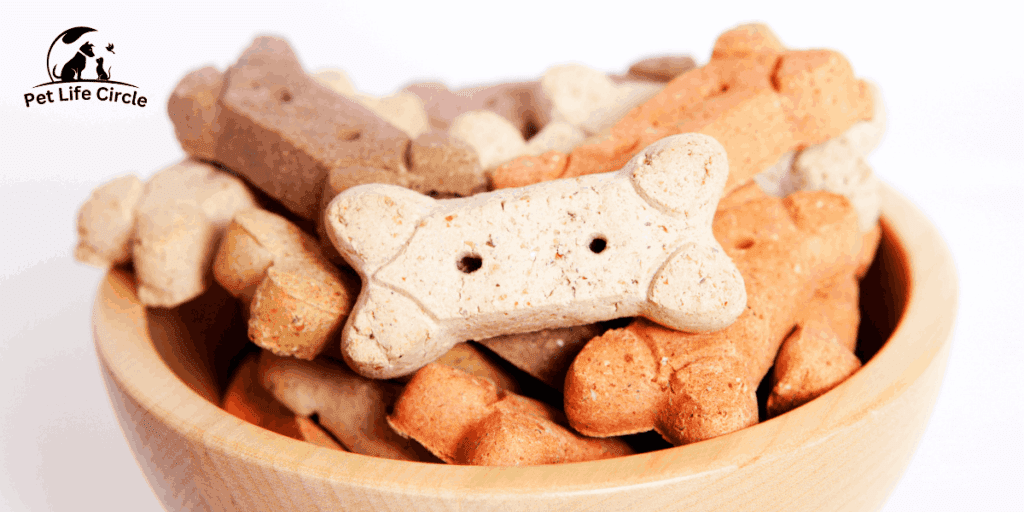Dog Calming Treats: A Complete Guide
Table of Contents
ToggleImagine two dogs: an energetic Australian Shepherd who never seems to run out of steam and a timid Italian Greyhound who bolts under the couch at the slightest loud noise. While these two dogs have vastly different personalities, they share one thing in common—both could benefit from calming treats.
Whether it’s separation anxiety, fireworks, thunderstorms, or general nervousness, many dogs experience stress and anxiety just like humans do. More and more pet parents are turning to solutions like calming treats to help their furry friends find some relief. These treats typically contain natural ingredients such as melatonin and chamomile, which promote relaxation.
However, choosing the right one can be overwhelming, with many different brands and formulations on the market. The best choice depends on several factors, including your dog’s breed, dietary restrictions, specific anxiety triggers, and overall health.
To help you make an informed decision, we’ve gathered expert insights from veterinarians, trainers, and genuine dog owners to break down everything you need to know about dog calming treats—how they work, what to look for, and whether they’re the right choice for your pup.
Signs That Your Dog May Need Calming Treats
Every dog experiences occasional stress, but how do you know when your pup might benefit from a calming supplement? Not all anxious behaviors require intervention, but it may be time to consider solutions like calming treatments if stress becomes frequent or overwhelming.
Common Signs of Anxiety in Dogs
Dogs communicate their stress through body language and behavior. Some signs are obvious, while others may be more subtle. Look for these indicators that your dog may be struggling with anxiety:
1. Excessive Barking or Whining
- If your dog vocalizes excessively, especially when left alone or in certain situations (e.g., thunderstorms or car rides), they might be experiencing anxiety.
2. Pacing and Restlessness
- Anxious dogs often struggle to settle down, pace back and forth, or exhibit repetitive behaviors.
3. Destructive Behavior
- Chewing furniture, digging at doors, or shredding household items can be signs of stress, mainly when your dog is alone.
4. Trembling or Cowering
- Dogs that shake, tuck their tails, or hide in response to loud noises or unfamiliar people may be experiencing situational anxiety.
5. Excessive Licking or Grooming
- Overgrooming, including obsessive licking of their paws or body, can be a self-soothing behavior linked to anxiety.
6. Sudden Aggression or Withdrawal
- Anxiety can cause behavioral changes, making some dogs more reactive or fearful. If your ordinarily social pup suddenly avoids interaction or displays aggression, it may be anxiety-related.
7. Changes in Appetite
- An anxious dog may lose interest in food or, conversely, engage in stress eating. Sudden changes in eating habits should constantly be monitored.

When to Introduce Calming Treats
If your dog exhibits one or more of these symptoms frequently or in response to specific triggers, calming treats may help reduce their stress and improve their well-being. They are instrumental for:
✅ Dogs with mild to moderate anxiety symptoms
✅ Situational stress (travel, fireworks, vet visits, thunderstorms)
✅ Rescue dogs adjusting to a new environment
✅ Senior dogs experiencing cognitive-related anxiety
✅ High-energy dogs that struggle to settle down
However, if anxiety is severe, persistent, or worsening, calming treats alone may not be enough. Consulting a veterinarian or a professional dog behaviorist is essential to develop a comprehensive anxiety management plan.
How Do Dog Calming Treats Work?
Calming treats, sometimes called calming chews or bites, are dietary supplements designed to help dogs manage anxiety and stress. They target the nervous system and reduce the body’s stress response. These treats typically contain natural compounds that support relaxation without causing excessive drowsiness.

Key Ingredients in Calming Treats and Their Benefits
Not all calming treats are the same—different ingredients target different types of anxiety. Some dogs may respond better to one ingredient than another, so understanding the active components can help you make the best choice.
| Ingredient | Function |
| L-Tryptophan | An amino acid that helps produce serotonin, which regulates mood and promotes relaxation. |
| L-Theanine | This amino acid is found in green tea and helps reduce anxiety and improve focus. |
| Valerian Root | A natural sedative that promotes calmness and reduces restlessness. |
| Melatonin | A hormone that supports healthy sleep patterns and can help dogs relax in stressful situations. |
| Chamomile | A well-known herb with mild sedative properties that help ease anxiety. |
| Passionflower | A botanical known for its calming effects, often used for acute anxiety. |
| CBD or Hemp Oil | Though research is still ongoing, it may help lower cortisol levels and ease tension. |
| Thiamine (Vitamin B1) | It supports the central nervous system and helps prevent anxiety-related deficiencies. |
| Ginger Root | It can help with nausea-related anxiety, especially in dogs prone to motion sickness. |
How Quickly Do Calming Treats Work?
The onset time depends on the treat’s formula and your dog’s metabolism. In general:
- Fast-acting treats: Work within 30 minutes to an hour, ideal for thunderstorms or vet visits.
- Slow-release treats: It may take a few weeks of consistent use to see long-term improvements in behavior.
For best results, administer calming treats 20-30 minutes before an anticipated stressful event.

Understanding the Root Causes of Canine Anxiety
Before reaching for calming treats, it’s essential to understand why your dog is experiencing anxiety. Addressing the underlying cause can improve the effectiveness of calming aids and help you tailor a more holistic approach to managing stress.
Common Causes of Anxiety in Dogs
Anxiety in dogs can stem from various sources, including environmental changes, past trauma, or even genetic predisposition. Below are some of the most frequent causes:
- Separation Anxiety – Dogs who form strong attachments to their owners may become distressed when left alone. Symptoms include destructive behavior, excessive barking, and house soiling.
- Noise Phobia – Fireworks, thunderstorms, and loud household noises (e.g., vacuum cleaners) can trigger fear responses.
- Social Anxiety – Some dogs may become fearful or aggressive around unfamiliar people or animals, often due to poor socialization.
- Travel Anxiety – Car rides, plane trips, and new environments can be unsettling, leading to nausea, excessive drooling, or trembling.
- Medical Conditions – Pain, cognitive dysfunction in older dogs, or hormonal imbalances can manifest as anxiety-like behaviors.
How to Identify Your Dog’s Anxiety Triggers
Recognizing patterns in your dog’s behavior is key to understanding their anxiety. Keep an eye out for these common signs of stress:
✅ Excessive panting or drooling (even when it’s not hot)
✅ Pacing or restlessness
✅ Tucked tail, flattened ears, or cowering
✅ Licking lips or yawning excessively
✅ Destructive chewing or digging
✅ Sudden aggression or withdrawal

Addressing Anxiety Beyond Treats
While calming treats can help alleviate symptoms, they work best with training techniques and environmental adjustments. Here are additional strategies to complement calming aids:
- Desensitization Training – Gradually exposing your dog to their fear trigger in a controlled manner can help reduce reactivity.
- Positive Reinforcement – Reward calm behavior with treats, praise, or favorite toys to reinforce a sense of security.
- Routine & Stability – A consistent daily schedule helps reduce anxiety by providing predictability.
- Physical and mental Exercise—A well-exercised dog is a calmer dog. Activities like puzzle toys and agility training provide mental stimulation.
Understanding the root cause of your dog’s anxiety is the first step toward an effective treatment plan. Combining calming treats with targeted interventions can provide long-term relief and improve your dog’s overall well-being.
Choosing the Right Calming Treats for Your Dog
When selecting a calming treat, consider the following factors:
1. Ingredients & Safety
- Look for natural ingredients like chamomile, valerian root, or L-theanine.
- Avoid artificial preservatives, colors, and fillers.
- Check for allergies like chicken, dairy, or grain if your dog has allergies.
- Consult your veterinarian before introducing any new supplement.
2. Your Dog’s Size & Anxiety Level
- Small dogs need lower doses than large breeds.
- Highly anxious dogs may require a more potent formula or a combination of solutions.
3. Type of Anxiety
- Situational anxiety (fireworks, car rides, vet visits): Look for fast-acting ingredients like melatonin or valerian root.
- Separation anxiety: Slow-release formulas with daily doses of L-theanine or CBD may be more effective.
- General nervousness: A blend of calming herbs and vitamins can help support a relaxed state.
4. Treat Form & Taste
- Soft chews, crunchy biscuits, or flavored powders—choose a form your dog will eat.
- Some treats double as dental chews for extra benefits.
5. Brand Reputation
- Look for brands with veterinarian-backed research and positive customer reviews.
- Choose treats manufactured in a GMP-compliant facility to ensure safety and quality.

Best Calming Treats for Dogs
Here are some highly rated calming treats based on effectiveness and ingredient quality:
| Brand | Key Ingredients | Best For |
| Zesty Paws Calming Bites | L-theanine, chamomile, valerian root | General anxiety & hyperactivity |
| Pet Naturals Calming Treats | L-theanine, colostrum | Stressful events (vet visits, travel) |
| Nutramax Solliquin | L-theanine, tryptophan | Daily anxiety relief |
| Alpha Paw Calming Treats | Chamomile, hemp | Nervous behavior & hyperactivity |
| NaturVet Quiet Moments | L-tryptophan, ginger | Motion sickness & travel anxiety |
| Greenies Calming Chews | L-theanine, L-tryptophan | Occasional stress relief |
| Kradle Bliss Bars | Passionflower, tryptophan | Separation anxiety & stress events |
How Long Do Dog Calming Treats Last?
The effects typically last 4-8 hours, depending on:
- Your dog’s metabolism and weight
- The treat’s formulation
- How frequently they are given
For ongoing anxiety issues, consistent use may be necessary.
What If Calming Treats Don’t Work?
If your dog doesn’t respond well to calming treats, it may indicate:
- The treatment isn’t strong enough for their level of anxiety.
- The anxiety is due to a medical issue that needs veterinary attention.
- A behavioral training plan or other calming aids may be required.
Alternatives to Calming Treats
- Anxiety vests: Gentle pressure vests (like the ThunderShirt) can help dogs feel more secure.
- Pheromone diffusers & sprays: Mimic calming scents that mother dogs produce.
- Interactive toys & puzzles: Mental stimulation can help reduce anxiety.
- Veterinary-prescribed medication: Your vet may recommend prescription anti-anxiety medication for severe cases.
Final Thoughts
Dog calming treats can effectively manage anxiety but aren’t a one-size-fits-all solution. Some dogs respond well to these supplements, while others may require a combination of calming methods, training, or even medical intervention.
Always consult your vet before introducing any new supplement, especially if your dog is on medication or has existing health conditions. With the right approach, you can help your furry companion feel more relaxed and comfortable.
FAQs About Dog Calming Treats
1. Are Calming Treats Safe for All Dogs?
Yes, most calming treats are safe for dogs when used as directed. However, it’s essential to check the ingredients for potential allergens and avoid giving more than the recommended dosage. If your dog has underlying health conditions or takes medication, consult your vet before introducing calming treats.
2. How Often Can I Give My Dog Calming Treats?
The frequency depends on the specific product and your dog’s needs. Some calming treats are designed for daily use, while others are meant for occasional stressors like thunderstorms or vet visits. Always follow the manufacturer’s guidelines and adjust based on your dog’s response.
3. Can Puppies Have Calming Treats?
Some calming treats are formulated for puppies, but not all. If your puppy is experiencing anxiety, look for puppy-safe formulas with gentle ingredients like chamomile and L-theanine. Always check the packaging and consult your vet before giving calming treats to a young dog.
4. Will Calming Treats Make My Dog Sleepy?
Calming treats are designed to relax dogs, not necessarily make them drowsy. However, some ingredients, such as melatonin or valerian root, may cause mild sleepiness. Reduce the dosage or try a different formulation if you notice excessive lethargy.
5. What Should I Do If My Dog Eats Too Many Calming Treats?
If your dog consumes more than the recommended dosage, monitor them for signs of over-sedation, stomach upset, or unusual behavior. In cases of severe symptoms like vomiting, tremors, or difficulty walking, contact your veterinarian or the ASPCA Animal Poison Control Center immediately.
Have you tried calming treats for your dog? What worked best? Share your experiences below! 🐾



